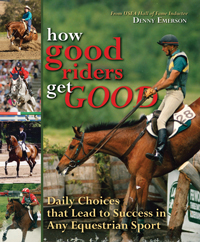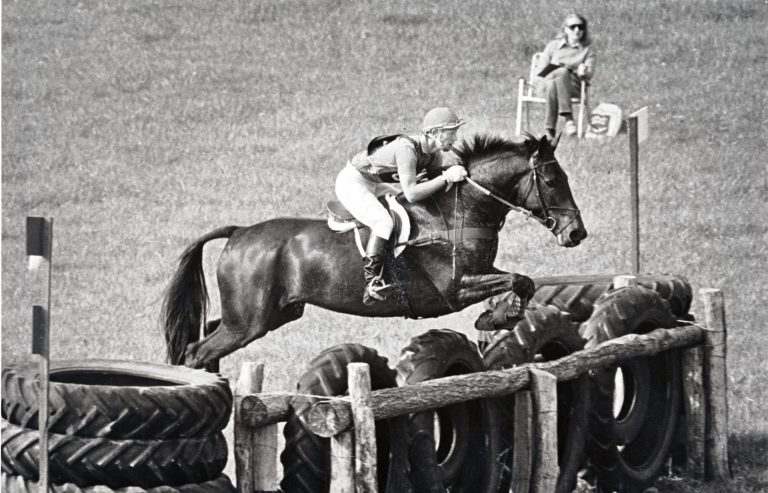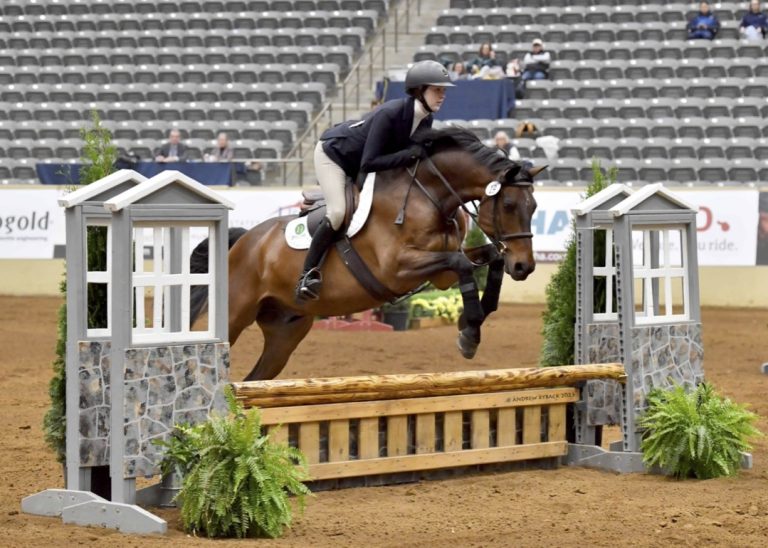If your location is not where your sport of choice is happening, you either have to remain outside the mainstream of your sport, or you have to “go where the action is” — which is what I did in order to learn to become a three-day-event rider.

I went to watch my first three-day event, the 1961 Wofford Cup held at Groton House Farm in Hamilton, Mass. At the time I was majoring in English at Dartmouth College and had a summer job at a Morgan horse farm in Randolph, Vt. But I was blown away by what those event horses and riders were doing on cross-country, and decided then and there that I was going to be a three-day rider.
In retrospect, I actually think I envisioned more than that. At that moment, I decided that I would become a champion three-day rider, and ride for the US Equestrian Team. Such is the arrogance and ignorance of youth! But remember, it had been less than a decade since, at age thirteen and with zero background in distance riding, I had decided to ride in the GMHA 100.
At age 20 I had never jumped a fence. I knew absolutely nothing about dressage. I owned a Morgan show horse, not an event horse. I’d seen one event in my entire life. Not exactly ideal life circumstances for an aspiring champion three-day rider! But when I got back to my job at the Green Mountain Stock Farm at the end of the weekend, I announced to farm trainer Art Titus that I wanted to learn how to jump and asked him, “How do I do that?” Art’s answer: “Put up a jump one foot high, jump it until you get bored, then raise it.”
This was the beginning of my jumping career. I was quickly bored with one-foot jumps. I’d like to say that was because of my superior talent, but more likely it was because I was a 20-year-old boy with more ambition and guts and drive than common sense. So I just started jumping bigger fences. Because I’d ridden so many thousands of hours already, I had good balance and no fear. It didn’t take long before I felt comfortable and secure.
When I look at old photographs of my early jumping style, I realize that I was a poster boy for cardinal jumping sins: my stirrups were too long, my body position was too far forward, my eyes looked down and my lower legs swung back. But I didn’t care, because I was convinced that I was God’s gift to the equitation world. It’s great to be young and ignorant, two words that I’ve increasingly come to believe are almost synonymous!
Back at Dartmouth that fall, I did three things to start me off on my brand new career. I sold my Morgan. I bought two books on dressage, A.L. D’Endrody’s Give Your Horse a Chance and Waldemar Seunig’s Essence of Horsemanship. And I got in touch with Joe McLaughlin, who ran Hitching Post Farm, a girls’ summer eventing camp in Royalton, Vt., and a thirty-five to forty-minute drive from Dartmouth. For the next two years, I spent every free moment at Hitching Post, riding every horse Joe would let me sit on. If I’d given my car its head, it would probably have driven there by itself.
I also discovered that H.L.M. Van Schaik, a member of the Dutch Olympic silver medal Grand Prix Show Jumping team for the 1936 Berlin Olympics, was living in Cavendish, Vt.–only a few miles from my parents’ farm in South Reading. In the spring of 1962 I bought a five-year-old Thoroughbred, Lighting Magic (“Dennis”), from Henry and Janet Schurink. With Mr. Van Schaik’s help, I started preparing him for the 1962 Green Mountain Horse Association Preliminary Level Three-Day.
Thirty horses competed, a huge entry in those early days of eventing. Steeplechase took place down in the valley floor, on the GMHA meadows. The second roads and tracks ran straight up the mountain to Lloyd and Stella Reeves’ Flying Heels Farm, and the cross-country course went up over the top of the mountain and down the other side. How we survived–a totally green event rider on a totally green five-year-old event horse–remains a mystery to this day, but nineteen pairs finished the event, and Lighting Magic and I were nineteenth.
My graduation from college in June 1963 was the point at which I made some choices that probably “opened the door” to other choices. This series of decisions resulted, eleven years later, in my standing in the arena at the Burghley (England) World Championship Three-Day Event with my teammates Don Sachey, Mike Plumb, and Bruce Davidson, receiving a gold medal from Great Britain’s Prince Philip and hearing the “Star Spangled Banner” on the arena speaker as the US flag was raised.
I didn’t foresee all this back in 1963, but I’m pretty sure I hoped for something like it. What I did know was that I wanted to become a really good event rider, and I needed to figure out how to make that happen. So here were the choices I made.
- I decided that in order to have time to ride, I’d need more free time than a conventional nine-to-five job would allow. Teaching school struck me as the “day job” career that would give me late afternoons off, plus weekends, plus summer vacations–even though the pay was terrible.
- I learned that there was an opening available in the English department at Far Hills Country Day School in New Jersey. Far Hills is next door to Gladstone, New Jersey, which was then the site of the United States Equestrian Team (USET) training headquarters for both show jumping and eventing.
- I drove down from New Hampshire for a job interview one spring weekend and was hired to teach sixth grade English for the 1963-1964 school year at Far Hills Country Day.
In 1963, the USET headquarters was in the midst of thousands of acres of pristine riding country that was also the home territory of the Essex Foxhounds. Highways, subdivisions, and golf courses have cut into much of the riding area by now, but in those days the whole Far Hills, Bernardsville, Peapack-Gladstone area of New Jersey was one of the premier places to ride in America.
For the next two years I was in the middle of all that horse activity, and I plunged in heart and soul. I hunted with Essex, some days for seven or eight hours. On weekends I could watch legendary coach Bert DeNemethy teach the great USET show jumping squad–fabulous riders like Frank Chapot, Kathy Kusner, Mary Mairs, Bernie Traurig, Billy Robertson, and the “the man” himself, Bill Steinkraus, who in just five years would win the individual gold medal at the 1968 Olympics in Mexico City on Snowbound.
The three-day team was then coached by another Hungarian expatriate, Stephan Von Visy. Michael Page, Mike Plumb, Lana duPont, Kevin Freeman, and Jim Wofford were among the three-day squad who either lived full time at the team headquarters in Gladstone or came in for weeks or months at a time–and I could watch their training sessions, as well.
I became friends with Denny Crawford, an avid eventer, and through him, with General “Fuddy” Wing, a former Olympic show jumper and a USET official. Often, Denny and his wife Ailsa would take Lighting Magic and me to events in Maryland and Virginia, where I’d compete at Preliminary Level and Denny would compete his Royal Nubbins at Intermediate.
I raced Lighting Magic in the 1964 Essex Point-to-Point, took dressage clinics with Major Dezso Szilagyi (a product of the famous Hungarian riding school and author of Basic Classical Dressage), showed in hunter and jumper classes at local shows, and taught lessons to Essex Pony Club kids, many of whom I also taught at Far Hills Country Day. In short, I had engineered my own life circumstances to further my riding goals.
I recently was able to “time travel” back to those crucial years when I found some old diaries of mine among boxes of effects left in my parents’ Vermont house. My entries from 1965, when I was twenty-three, show how totally I involved myself in the rich horse environment to which I’d relocated:
January 7
Dennis shod — winter (borium tips).
January 9
Hunted from Brady’s about 4? hours. Good hunt — five to ground.
January 11
Rode Sextet for Dr. Lohmeyer, worked Folly, did all stalls.
January 30
USCTA [United States Combined Training Association] luncheon, NYC. Polo, Squadron A Armory. Dennis high-point horse, USCTA, 1964.
Subsequent entries chronicle my riding in everything from below-zero cold snaps to February mud. On a late-March trip to Southern Pines with Dennis, I also rode every other horse that crossed my path, including a green colt that bucked me off. By summer, Dennis and I were going Intermediate in eventing, and I was also competing him in dressage and show jumping.
When I looked through those old journals recently, I had few active memories of the nonstop riding and learning experiences they chronicled — but I was a horse fanatic, pure and simple. And I was laying the foundation for my future career.
Rider Profile: Anne Gribbons
Anne rode Metallic for the US team that won a silver medal at the 1995 Pan American Games. Medical issues prevented her trying out for the 1996 Olympic team, but her horse–who she had trained from the beginning up to Grand Prix–went to the Olympics with Robert Dover and helped win a team bronze.

Discipline:
Dressage
After earning her USDF (United States Dressage Federation) gold medal with the Thoroughbred ex-racehorse Tappan Zee, Anne schooled a succession of other horses up to Grand Prix, showing some of them at elite European venues such as Aachen and Falsterbo while training abroad. She has become a renowned teacher and an FEI “O” judge, as well as a popular writer. In 2009, she was appointed as technical advisor for the USET dressage squad from the 2010 World Equestrian Games through the 2012 Olympics.
Life circumstances:
I grew up with horses in my genes. My grandfather was a head of Swedish cavalry, and I used to sit on his lap as he painted watercolor scenes from his cavalry days.
Hooked on horses when:
I think one of the first things I said was “horse.”
I think I got good because:
I couldn’t have a horse of my own (my parents and four children–including me– lived in an apartment in Gothenburg, Sweden), but I religiously took lessons at the nearby riding school, where I got good enough to be trusted with some of the greener school horses, and eventually exercised some of the boarders’ horses.
Then they started giving me rogues that no one else wanted to, or could, ride. I hit the ground often but I learned to stay on. And I got help from the wonderful teachers there.
After I switched to dressage from my first love, eventing, in the 1970s, I was lucky enough–through a sheer accident of timing–to work with some of the masters. Colonel Bengt Ljungquist was my foundation and my mentor for eight years until his unexpected death in 1979. That was upsetting; when I finally pulled myself together, I was able to arrange training tours in Europe with Harry Boldt, Herbert Rehbein, and Dr. Volker Moritz.
I bond with my horses. They’ve stayed with me, and I have trained most of them up from the beginning, or at least from a very early stage. It really makes a difference when a rider has a strong relationship with a horse; I can tell if there’s that kind of bond when I’m judging.

My most important advice:
If you’re serious, first of all get a trainer you can trust-not necessarily a genius or the biggest name, but someone you know can get the job done, is interested in you and wants to promote you, and who will tell you the truth and stick by you when the going gets rough. Then, ride every single horse you have the opportunity to ride. Anybody can learn to ride one horse. Riding a multitude of horses and figuring them all out–that’s what makes you a rider and a trainer.
To read another excerpt from How Good Riders Get Good, see “Dealing with the Cards You Hold” in the February 2011 issue of Practical Horseman magazine. To purchase a copy of the book, which is published by Trafalgar Square Books, go to www.HorseBooksEtc.com.










